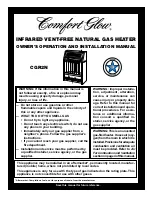
8
TNR-I&S-02
3. For horizontal, the venting system shall terminate 4 foot below, 4
foot horizontally from or 1 foot above any door, window, or gravity
air inlet into building.
4. The manufacturer also recommends the vent system terminations
not be installed closer than 3 feet from an inside corner of an L
shaped structure.
5. The vent termination shall not be mounted directly above or within
3 feet horizontally from an oil tank vent or gas meter to avoid
potential freeze-up from condensation.
6. The vent shall terminate a minimum of 12 inches above expected
snowfall level to prevent blockage of vent termination.
Vent pipes serving power vented appliances are classified by building
codes as “vent connectors”. Required clearances from combustible materials
must be provided in accordance with information in this manual under
LOCATION OF WATER HEATER and CLEARANCES, and with National Fuel Gas
Code and local codes.
Horizontal Installation:
In a horizontal application, it is important that condensate not be allowed
to buildup in the exhaust vent pipe. To prevent this from happening the
pipe should be installed with an slight upward slope so the condensate will
run back toward the water heater. The vent system should be supported
every 5 feet of vertical run and every 3 feet of horizontal run of vent pipe
length.
Stress levels in the pipe and fittings can be significantly increased by
improper installation. If rigid pipe clamps are used to hold the pipe in
place, or if the pipe cannot move freely through a wall penetration, the
pipe may be directly stressed, or high thermal stresses may be formed
when the pipe heats up and expands. Install accordingly to minimize such
stresses.
Follow the following procedure to vent through the wall:
1.
Cut two 3 1/2 in.
(8.9 cm)
diameter holes (for 3"
(7.6 cm)
diameter
pipe) or 4 ½”
(11.4 cm)
diameter holes (for 4"
(10.2 cm)
diameter
pipe) in the wall with the centerline hole distances at least 18"
(45.72 cm)
apart in the location where the exhaust vent and air
intake terminals will exit the outside wall if vented on the same wall.
2.
Use the proper PVC cement to secure the 90° exhaust vent and air
intake terminals provided with the water heater to the plastic pipes.
The distance between the back edge of the 90° exhaust vent terminal
and the exterior wall (see Figure 11) must be 6 inches
(12.7 cm)
more for the exhaust vent terminal than the air intake terminal. Use
the proper cement or sealant and assembly procedures to secure the
vent connector joints between the terminal and the blower outlet.
Provide support brackets for every 3 feet
(.91 m)
of horizontal vent.
Vertical Installation:
Vertical venting system
must be
supported every 5 feet of vertical run
and every 3 feet of horizontal run of vent pipe length.
Stress levels in the pipe and fittings can be significantly increased by
improper installation. If rigid pipe clamps are used to hold the pipe in
place, or if the pipe cannot move freely through a wall penetration, the
pipe may be directly stressed, or high thermal stresses may be formed
when the pipe heats up and expands. Install accordingly to minimize such
stresses.
Follow the following procedure to vent through the roof:
1.
Cut the necessary holes through the roof and ceiling.
2.
Install the exhaust vent and air intake plastic pipes as shown in
Figure 12. Make sure that the installation meets the local codes
and/or The National Fuel Gas Code ANSI Z223.1 (Latest Edition) or
CGA/CAN B149 Installation Code.
Figure 11. Typical Horizontal Direct Vent System
NOTICE
This unit can be vented using only PVC (Class 160, ASTM D-2241 Schedule
40, ASTM D-1785; or Cellular Core Schedule 40 DWV, ASTM F-891),
Schedule 40 CPVC (ASTM F-411). The fittings, other than the
TERMINATIONS should be equivalent to PVC-DWV fittings meeting ASTM
F-2665. (Use CPVC fittings, ASTM F-438 for CPVC pipe.) If CPVC pipe
and fittings are used, then the proper cement must be used for all
joints, including joining the pipe to the Termination (PVC material). PVC
materials should use ASTM –D2564 grade cement; CPVC materials
should use ASTM F-493 grade cement.
For water heaters in locations with high ambient temperatures (above
100° F) and/or insufficient dilution air, it is recommended that CPVC
pipe and fittings (MUST USE SUPPLIED VENT TERMINAL) be used.






































